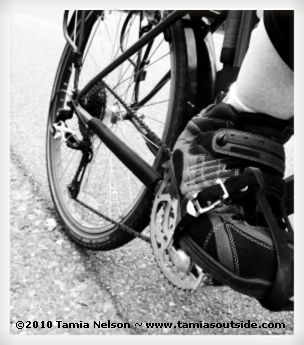
We’d all like to be stronger and faster. But none of us—at least no one I know, notwithstanding the appeal of 50 Shades of Grey—really gets off on pain. Which is why cyclists are always suckers for the newest New Big Thing. The implicit contract between seller and cyclist is simple: Buy this [saddle, crankset, brifter, wheel, bike] and you’ll go farther and faster than you’ve ever gone before, without having to work any harder. And the argument is almost impossible to resist. That’s probably a good thing. After all, bicycles last just about forever, are easy to maintain, and require little in the way of costly consumables. (For instance, I can outfit my bike with enough chains, tires, and brake blocks for several years and many thousands of miles, all for less than the cost of a single fill-up for an SUV.) So local bike shops often depend on component upgrades to pay the bills, and the world would be a much poorer place without those shops.
Nonetheless, the promise implicit in the glossy ads is a lie. You can’t buy better legs. The only reliable road to greater speed and stamina is the hard highway of pain. Plus buckets and buckets of sweat. This stark fact was neatly summarized by none other than Eddy Merckx, in what has become an oft-quoted line. When asked to give advice to budding racers, he replied simply, “Don’t buy upgrades. Ride. Up. Grades.”
I often think of this when I do battle with the local hills. Of course, I’m no racer. And I never will be. But living where I do, I can’t travel more than 100 yards without climbing a hill, and the grades are both steep (to better than 1-in-4, according to my Brunton Pocket Transit) and long. A shopping trip requires that I climb 550 feet with my load of groceries, on a road that culminates in a one-mile-long hill, boasting an average 1-in-15 grade. It’s a far cry from the Alps, I know, and it’s a good day when I top 8 mph on the steeper 1-in-10 bits of the climb, but the effort is still enough to make my thighs ache.
This is nothing new. I’m not a natural climber. I have a sprinter’s strength, and I can plummet downhill at speed, leaving Farwell—who freely confesses to being a timid descender—far behind. But the hills… Well, let’s just say that the hills take their toll. Still, I’ve never been tempted by the siren song of the latest New Big Thing. There’s the cost, for starters. Apart from the Grey lady and a few others, hacks don’t get rich. Mostly, though, it’s common sense. There’s no public transit where I live. Even cell phone coverage is spotty. And I often take the road less traveled. So when trouble strikes, I’m on my own. Which means that even on local trips, I have to carry a pretty fair collection of tools and spares, not to mention extra food and water. Saving a few grams on a seatpost or stem wouldn’t go far to offset my usual 2+ liters of water, let alone the weight of panniers and groceries.
The upshot? I follow Eddy Merckx’s advice. I don’t buy upgrades for my bike. I ride up grades, instead. I don’t have a choice, of course. But once the summer sun frees the local roads from winter’s legacy of ice and salty slush, and I no longer have to creep cautiously along on studded tires, I begin challenging the hills in earnest again. The benefits soon follow. I start shedding my winter overcoat of fat, for one thing, and my average speed increases steadily from one day to the next. Improvement comes slowly, to be sure, but it does come. And as the summer weeks tick by, my local hills get smaller, their grades less taxing. The geologist in me can’t explain this curious phenomenon, but as a cyclist I have no difficulty in understanding it.
Which leads inevitably to another piece of advice that Eddy Merckx gave aspiring racers: “Ride lots!” Was there ever an easier prescription to swallow? I doubt it. And now I think I’ll go for a spin. Just to see how the hills are shrinking, you understand.
Further Reading
- “Making the Grade: Cake Isn’t Bad for Cyclists, Hills Are…”
- “Climbing the Walls: The Joy of Granny Gears”
- “The Day I Rode With Eddy Merckx”
Questions? Comments? Just click here!
